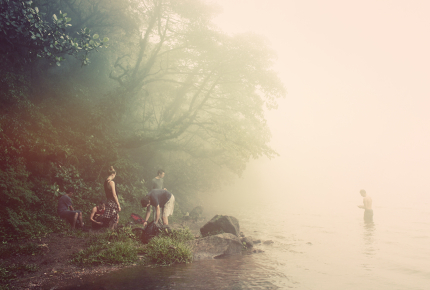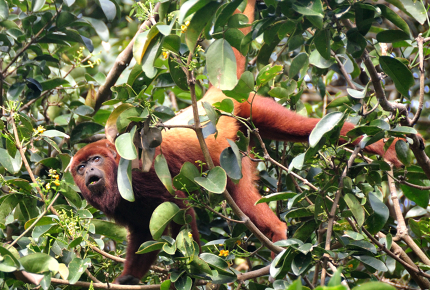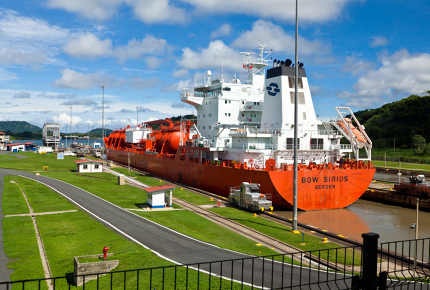Has Nicaragua been sold down the river?
Protests, precious rainforest and one of the world’s poorest countries – Darren Loucaides asks if the Nicaragua Canal will turn out to be a poisoned chalice.
As dawn broke, the Rio San Juan began to throb into life. Earlier, the only sound on the river was our motorised canoe, but now the distant roar of howler monkeys rose above frantic birdsong and flapping macaws.
Already dazzling, the primordial rainforest of the Indio Maíz Biological Reserve was slowly heaving towards us.
However, my guide Darwin was shaking his head.
“Such damage and destruction, for nothing,” he whispered. “What will happen to the environment, to la naturaleza (the nature)?”
He was talking about the controversial Nicaragua Canal, which will stretch across 280km (174 miles) and connect the Pacific and Caribbean Oceans at a cost of $50 billion.
Carving through precious rainforest, the canal will displace tens of thousands of farmers, villagers and indigenous tribes – it will also belong to a Chinese-based infrastructure firm, the HKND Group, until the 22nd century.
Naturally, many Nicaraguans are unhappy.
Demonstrations turned violent in December as protesters set up road blocks in Rivas and El Tule, while Nicaraguan politicians and civil society organisations voiced their distaste via an open letter at the Community of Latin American and Caribbean States (CELAC) summit last week.
In response, the HKND Group (which is building the canal in agreement with the Nicaraguan government) published a report estimating that 50,000 jobs will be created - around half of them for Nicaraguans, who lack the expertise to take on all the roles.
The economic stimulus could transform Nicaragua and reduce the current unemployment rate of 40%. Supporters point to Panama, whose canal helped turn it into the second-richest country in Latin America.
 Nicaragua is one of the world’s poorest countries
Nicaragua is one of the world’s poorest countriesCreative Commons / Feed My Starving Children (FMSC)
I visited Nicaragua not long before work started in December, when the government was still conducting a study to determine possible routes.
Its logistical and financial results, including any environmental impact, are yet to be made public.
So, keen to see some of Nicaragua’s incredible biodiversity before it’s potentially lost forever, I headed to Rivas.
A quiet, unremarkable town, Rivas is set for an extreme makeover. Ground-breaking has already commenced here with the town earmarked as the canal’s starting point.
Like most tourists though, I was passing through to Lake Nicaragua, the largest freshwater lake in Central America.
Aboard a boat resembling a raft, I looked out across the deep-blue water to the incredible twin-volcano island of Ometepe.
Wreathed in cloud, the mighty 1,610m-high (5,282 ft) Concepción volcano rose up before me, its feet seeming to reach the very edges of the rugged, forested islet, while smaller Maderas peered out behind it.
The views on approach were staggering - but for how long?
In about five years, when the canal is set for completion, mega-ships capable of carrying 25,000 containers will pass through. They will dwarf those on the Panama Canal, which can only hold up to 5,000 containers each.
 The shores of Lake Nicaragua near Ometepe island
The shores of Lake Nicaragua near Ometepe islandCreative Commons / Thomas Frost Jensen
After spending a night in the sleepy town of Moyogalpa, I attempted to climb Concepción with local guide Robert.
Along the difficult hike up, through tangling trees and low-hanging fruit, Robert identified plants for different remedies – Ometepe’s inhabitants clearly have a close relationship with Mother Nature.
I heard the growl of howlers high above and glimpsed the white fur and pink faces of a few Capuchin monkeys in the distance. It was thrilling, but Robert looked troubled.
“Do you ever get tired of hiking the same way?” I asked.
“Never,” he replied. “Besides I have to enjoy the view while it lasts.”
After two hours, we reached a flat clearing – the main viewpoint at 1,000m (3,281 ft) high. It overlooked Ometepe’s raw forest and immaculate farmland; the few towns below resembled anthills.
Robert said that the island and its inhabitants had - more or less - remained the same forever, but soon Ometepe will overlook one of the busiest shipping routes in the world. A free-trade zone will operate around the canal, with planned residential and tourism complexes set to bring in plenty of money and lots of change.
Having crossed Lake Nicaragua by overnight barge, I found myself on another rickety boat trundling down the Rio San Juan in the morning.
Around midday, the quaint town of El Castillo rolled into view. In one of the pretty, multi-coloured houses-on-stilts, restaurant-owner Lenin pondered the future with me over a lunch of river shrimp.
“On the one hand, it could bring a lot of money to the country. Nicaragua is very poor,” he said. “But I am worried about what will happen to the environment.”
 Howler monkeys are a familiar sight in the Nicaraguan rainforest
Howler monkeys are a familiar sight in the Nicaraguan rainforestCreative Commons / ccotton
An hour’s boat ride from El Castillo is the Indio Maíz Biological Reserve. Dense and teeming with life, the number of plant and animal species in the rainforest trumps the whole of Europe.
Amongst tall ‘walking’ trees and monkey trees, local guide Darwin introduced me to rare birds, countless lizards and luminous frogs.
“Obviously there will be an enormous impact from the canal,” Darwin said back on the river.
Although one of the prospective routes had included the Rio San Juan, it's now set to enter from Lake Nicaragua, a couple of towns north of the river-mouth.
“With the lake feeding two rivers, it’s impossible to estimate the scale of the impact on the eco-system,” Darwin added.
Catching a boat from El Castillo, I was the only tourist to alight at San Juan de Nicaragua, a tiny town made up of a few wooden houses, a school and a football pitch. There were no cars.
In the only B&B, I met two Nicaraguans from the capital, Managua, visiting on behalf of an NGO. San Juan de Nicaragua has a mix of mestizo (mixed race) and Afro-Caribbean people, but there are some indigenous Rama living on the outskirts too, and that's who the pair were here to visit.
“They haven’t asked the Nicaraguan people,” one said of the government officials, “no one wants it.”
“It will completely disrupt the rainforest,” his colleague added, “and even more harm will be done to the indigenous people.”
In the morning, a guide called Alfredo took me out into the Caribbean by kayak. We paddled for ages past palm-lined islets, finally reaching a little alcove on the edge of the rainforest.
The trees were far taller and thicker than before, daylight almost completely obscured. I saw enormous butterflies, a salamander and kingfishers.
Having travelled about 300km (186 miles) by boat from Rivas to the Caribbean Sea, I was in truly virgin rainforest.
I wanted to venture in deeper and meet the Rama living there, but I consoled myself with a vow to return. I only hope that when I do, the canal hasn’t wrecked it all.
 A ship makes its way through a Panama Canal lock
A ship makes its way through a Panama Canal lockCreative Commons / Geoff Stearns
NEED TO KNOW
Getting there
American Airlines fly from London Heathrow to Managua, Nicaragua via Miami from £772.
How to visit
There are a few tour companies offering trips around Rio San Juan and the rainforest. Tours Nicaragua (toursnicaragua.com), which has been operating in the area since 1996, come highly recommended. However, it's possible to travel the route independently by using regular ferries and passenger boats. They aren’t luxurious, but comfortable enough.
More information
Nicaragua’s tourism industry is still fairly undeveloped, but visitors are beginning to take advantage of the soaring mountains, pretty beaches, rainforest and colonial architecture. See visitnicaragua.us for more.
Do you have any Feedback about this page?
© 2026 Columbus Travel Media Ltd. All rights reserved. No part of this site may be reproduced without our written permission, click here for information on Columbus Content Solutions.









 You know where
You know where